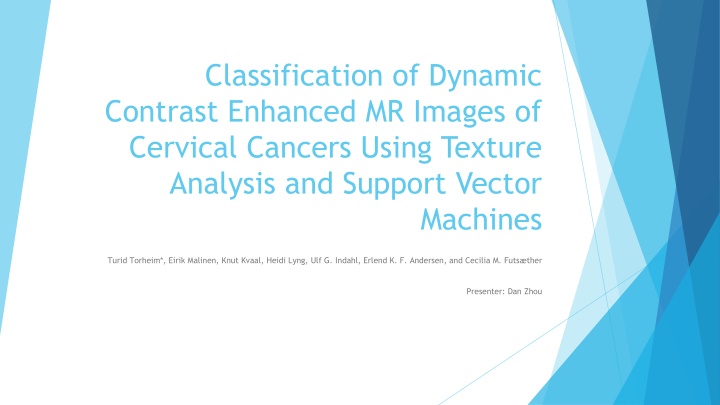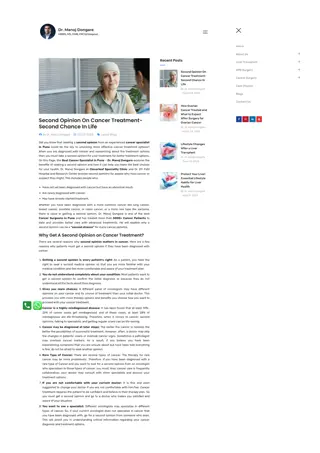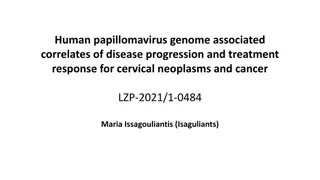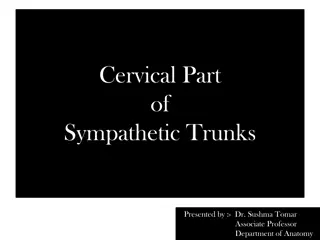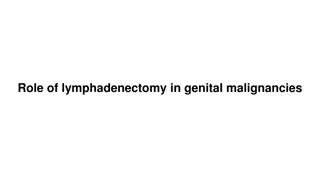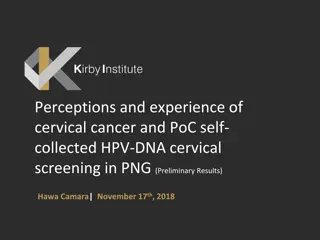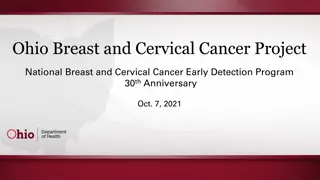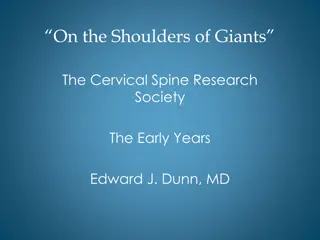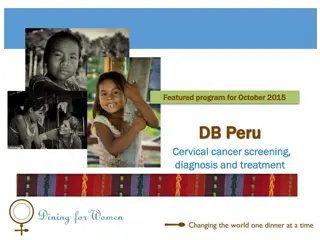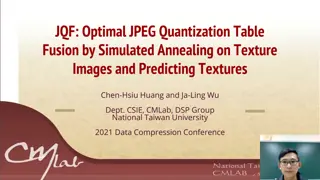Predicting Treatment Outcome in Cervical Cancer Using Texture Analysis and SVM
Determine if treatment outcome for locally advanced cervical cancer can be predicted using dynamic contrast-enhanced MR images. Texture analysis and support vector machines were used to differentiate between cured and relapsed patients based on spatial relations within the tumor. Statistical features and Brix parameters were analyzed, showing promising results for outcome prediction.
Download Presentation

Please find below an Image/Link to download the presentation.
The content on the website is provided AS IS for your information and personal use only. It may not be sold, licensed, or shared on other websites without obtaining consent from the author.If you encounter any issues during the download, it is possible that the publisher has removed the file from their server.
You are allowed to download the files provided on this website for personal or commercial use, subject to the condition that they are used lawfully. All files are the property of their respective owners.
The content on the website is provided AS IS for your information and personal use only. It may not be sold, licensed, or shared on other websites without obtaining consent from the author.
E N D
Presentation Transcript
Classification of Dynamic Contrast Enhanced MR Images of Cervical Cancers Using Texture Analysis and Support Vector Machines Turid Torheim*, Eirik Malinen, Knut Kvaal, Heidi Lyng, Ulf G. Indahl, Erlend K. F. Andersen, and Cecilia M. Futs ther Presenter: Dan Zhou
Crux The aim of the study was to determine whether treatment outcome for 81 patients with locally advanced cervical cancer could be predicted from parameters of the Brix pharmacokinetic model derived from dynamic contrast enhanced magnetic resonance imaging (DCE-MRI). Features derived from first-order statistics could not discriminate between cured and relapsed patients (specificity 0% 20%, p-values close to unity). However, second-order GLCM features could significantly predict treatment outcome with accuracies (~70%) similar to the clinical factors tumor volume and stage (69%). The results indicate that the spatial relations within the tumor, quantified by texture features, were more suitable for outcome prediction than first-order features.
Literature Review Previous studies have found correlations between DCE-MRI parameters and treatment outcome for locally advanced cervical cancers, for example in M. A. Zahra et al. However, these correlations do not necessarily imply that the Brix parameters can be used to predict the treatment outcome for a particular patient. Thus, the aim of the current study was to examine if the Brix pharmacokinetic classification model were able to predict treatment outcome.
Statistical Features First-order statistical features of the Brix parameters were used. texture analysis of Brix parameter maps was done by constructing gray level co-occurrence matrices (GLCM) from the maps. Clinical factors: tumor volume, FIGO stage
Brix Parameter A: amplitude Kep: the transfer rate of contrast agent from the tumor tissue to the blood stream Kel: the washout rate of contrast agent from the blood plasma.
First-Order Statistics The mean, median, mode, standard deviation, maximum and minimum value, skewness, kurtosis, percentile values, percentile widths of each Brix parameter A, Kep, Kel were calculated for each tumor.
texture analysis of Brix parameter Method: gray level co-occurrence matrix (GLCM) The GLCM is calculates how often a pixel with gray-level value i occurs from different direction to adjacent pixels with the value with the value j . Define distance (step length) and a direction
Second-order statistical texture features Constant K Energy E Correlation R Homogeneity H
Dataset The data in this study consisted of dynamic contrast enhanced (DCE) magnetic resonance images of 81 patients with locally advanced cervical cancer. The median tumor volume was 25 ; 24 for the cured patients and 37 for patients with relapse. 2 tumors had FIGO stage IB, 44 had stage II, 29 had stage III, and six had stage IVA. ??3 ??3 ??3
Feature Selection Feature selection was done by sorting the feature variables according to their ability to explain the total variance in the data set as follows. 1) Compute the total variance (T0) of the complete set of available variables, and set the required level (L<100% ) of explained variable variance by the selected subset. 2) Choose among the unselected variables the one with the largest variance. 3) Project the remaining variables onto the orthogonal complement of the subspace spanned by the selected one(s). 4) Compare the total variance (Tr) of the remaining (projected) variables with T0: If 100(1-(Tr/T0))%<L, then return to step 1) for selection of another variable. 5) The final collection of selected variables was used as predictors in the subsequent SVM classification.
Classification Support vector machines (SVM): soft margin SVM classes are not necessarily linearly separable in the original feature space, this paper used the radial basis function(RBF) kernel
Statistical Analysis and Model Validation evaluated using ANOVA and post hoc Tukey s HSD tests with significance level p<0.05 A selection of models were also validated using a leave-one-out cross-model validation
Conclusion for predicting outcome of chemoradiotherapy for cervical cancer patients, texture features from GLCMs of pharmacokinetic parameter maps derived from DCE-MRI appear to be better predictors than first-order statistical features and can compete with the clinical factors tumor volume and stage.
